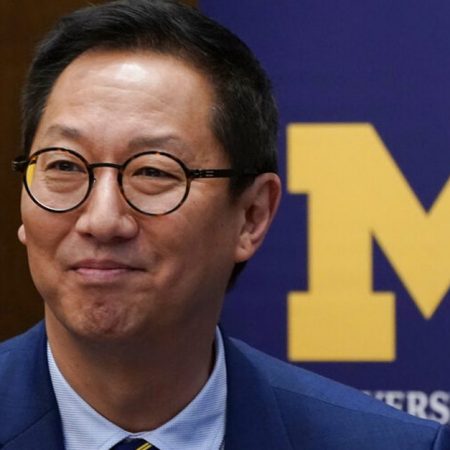Neon dreams and nature scenes make for two very different home decor trends in 2025
By KIM COOK, Associated Press
Home decor’s got a split personality this year: Call it “city glow” and “cottage flow.”
At the two international design fairs that I attended — Maison et Objet in France, Ambiente in Germany — acres of exhibition booths were full of Art Deco furnishings, island-vibe rattan seating and lighting, and lots of emphasis on sustainably produced materials.
But a couple of aesthetics drawing crowds were especially interesting.
Capturing the ‘city glow’
One was an exuberant urban vibe I’m nicknaming “city glow.” It’s full of highlighter-hued throw pillows, edgy surrealism, street art and hefty, Brutalist-style furniture — lots of sharp-cornered steel or concrete consoles and lamps that loomed over rooms — as well as rugs and wallcoverings covered in graffiti-style motifs or swaths of vibrant color.

Gretchen Rivera, an interior designer in Washington, D.C., sees it as a look that resonates especially with “younger generations who grew up with digital influences. There’s surrealist art, energetic colors and playful, almost toy-like design.”
Interior designer Anton Liakhov in Nice, France, agrees: “For a generation clamoring for creativity and self-expression, it’s loud and in-your-face.”
For surface colors, look at Benjamin Moore’s spicy orange Bryce Canyon or the bubblegum-pink Springtime Bloom. Daydream Apothecary has a whole collection of neon wall paints for intrepid decorators.

Sisters Ana and Lola Sánchez use art as a bold form of self-expression at their luxe brand Oliver Gal, in South Florida. It’s known for its handcrafted, statement-making pieces — including large acrylic gummy bears, graphic surfboards and wall art inspired by fashion, pop culture and modern surrealism. The result is a vibrant, edgy aesthetic.
A new collection, Rococo Pop, introduces rococo-inspired frames in high-gloss acrylics paired with playful graphic imagery. “We wanted to take the opulence of 18th century rococo,” notes Ana Sánchez, “and give it a cheeky, pop-art punch.”
“These frames are like little rebels in ballgowns — elegant, over-the-top and totally unexpected,” adds Lola Sánchez.
The style, her sister says, “celebrates contrast. Old World charm meets modern mischief.”
Following the ‘cottage flow’
The other impressive decor style at the design fairs was very different from the urban look. I’m calling this one “cottage flow,” and Liakhov describes it as evoking a “peaceful sanctuary, where you can play around with textures that are anchored in, and in tune with, nature.”
Think nubby woolen throws in mossy hues. Softly burnished wooden tables. Vintage quilts, and dishware. Gingham and garden florals. Landscape prints. Imagery of birds and woodland animals on textiles and wallcoverings.

Etsy’s 2025 spring/summer trend report showed that searches for “French cottage decor” were up over 26,000% compared to 2024.
“I see people embracing a slower pace to life where they can,” says New York-based interior and decor designer Kathy Kuo about the country cottage style.
“The past two decades or so were dominated by a glorification of fast-paced ‘hustle culture’ — trends like cottagecore and coastal grandmother are evidence that the pendulum’s swinging toward taking pleasure in simpler, more nature-adjacent things in life, whether or not you actually live in a country cottage,” she says.

Paint colors are also reflecting the trend. A calming sage green called Quietude is HGTV Home by Sherwin-Williams’ color of the year. Little-Greene’s collection has names like Rolling Fog, Tea with Florence and Hammock.
Mixing the styles
Watching design show visitors excitedly discovering new finds among the aisles, I thought THIS is what’s fun about home decorating: You can think as creatively as you like when it comes to your own home.
You’re all about high-octane city nightlife? Come this way.
Scottish crofts, Scandi cabins and cozy porches more your thing? Right over here.

And if you want to mix these two aesthetics? Go for it. There’s space to blend elements of both, says Kuo.
“Design trends are so fluid. I absolutely see the potential to merge these into each other,” she says. “Many city dwellers love time in nature and have an affinity for a more rustic look, while still feeling called to honor their urban environment in their home. I see plenty of modern interior design motifs that are sleek and urban on the surface, but in the details, they’re infused with organic textures and biophilic elements.”
“Really, the best designs are the ones that are personal, rather than perfect,” she adds.
You could display an array of contemporary glass bowls on a curvy walnut credenza. Mix botanical patterns in vibrant, unexpected colors. Soften room elements like a sleek table and industrial-style lamp with boucle or velvet cushions and a fluffy rug. Pair polished concrete floors with vintage-inspired wallcovering.
If you don’t want to mix elements in one space, consider using sliding partitions from one room to another. You’ll create a little style “journey.”
If the recent international design fairs are any indication, you’re going to find loads of fun home decor in stores over the coming months. Get ready to flow
New York-based writer Kim Cook covers design and decor topics regularly for The Associated Press. Follow her on Instagram at @kimcookhome.
































